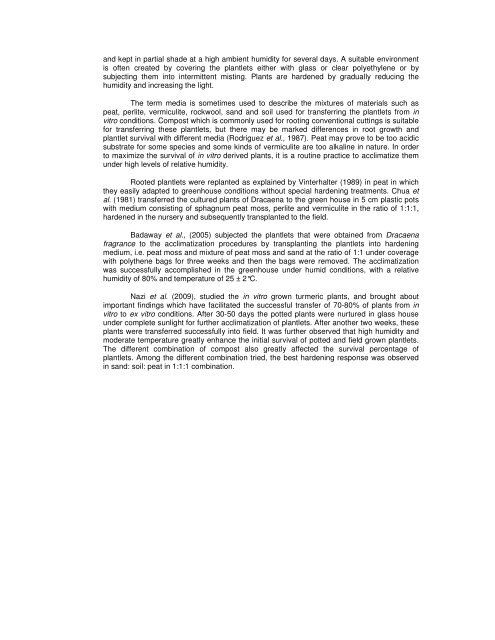micropropagation studies in dracaena and cordyline - ETD ...
micropropagation studies in dracaena and cordyline - ETD ...
micropropagation studies in dracaena and cordyline - ETD ...
You also want an ePaper? Increase the reach of your titles
YUMPU automatically turns print PDFs into web optimized ePapers that Google loves.
<strong>and</strong> kept <strong>in</strong> partial shade at a high ambient humidity for several days. A suitable environment<br />
is often created by cover<strong>in</strong>g the plantlets either with glass or clear polyethylene or by<br />
subject<strong>in</strong>g them <strong>in</strong>to <strong>in</strong>termittent mist<strong>in</strong>g. Plants are hardened by gradually reduc<strong>in</strong>g the<br />
humidity <strong>and</strong> <strong>in</strong>creas<strong>in</strong>g the light.<br />
The term media is sometimes used to describe the mixtures of materials such as<br />
peat, perlite, vermiculite, rockwool, s<strong>and</strong> <strong>and</strong> soil used for transferr<strong>in</strong>g the plantlets from <strong>in</strong><br />
vitro conditions. Compost which is commonly used for root<strong>in</strong>g conventional cutt<strong>in</strong>gs is suitable<br />
for transferr<strong>in</strong>g these plantlets, but there may be marked differences <strong>in</strong> root growth <strong>and</strong><br />
plantlet survival with different media (Rodriguez et al., 1987). Peat may prove to be too acidic<br />
substrate for some species <strong>and</strong> some k<strong>in</strong>ds of vermiculite are too alkal<strong>in</strong>e <strong>in</strong> nature. In order<br />
to maximize the survival of <strong>in</strong> vitro derived plants, it is a rout<strong>in</strong>e practice to acclimatize them<br />
under high levels of relative humidity.<br />
Rooted plantlets were replanted as expla<strong>in</strong>ed by V<strong>in</strong>terhalter (1989) <strong>in</strong> peat <strong>in</strong> which<br />
they easily adapted to greenhouse conditions without special harden<strong>in</strong>g treatments. Chua et<br />
al. (1981) transferred the cultured plants of Dracaena to the green house <strong>in</strong> 5 cm plastic pots<br />
with medium consist<strong>in</strong>g of sphagnum peat moss, perlite <strong>and</strong> vermiculite <strong>in</strong> the ratio of 1:1:1,<br />
hardened <strong>in</strong> the nursery <strong>and</strong> subsequently transplanted to the field.<br />
Badaway et al., (2005) subjected the plantlets that were obta<strong>in</strong>ed from Dracaena<br />
fragrance to the acclimatization procedures by transplant<strong>in</strong>g the plantlets <strong>in</strong>to harden<strong>in</strong>g<br />
medium, i.e. peat moss <strong>and</strong> mixture of peat moss <strong>and</strong> s<strong>and</strong> at the ratio of 1:1 under coverage<br />
with polythene bags for three weeks <strong>and</strong> then the bags were removed. The acclimatization<br />
was successfully accomplished <strong>in</strong> the greenhouse under humid conditions, with a relative<br />
humidity of 80% <strong>and</strong> temperature of 25 ± 2°C.<br />
Nazi et al. (2009), studied the <strong>in</strong> vitro grown turmeric plants, <strong>and</strong> brought about<br />
important f<strong>in</strong>d<strong>in</strong>gs which have facilitated the successful transfer of 70-80% of plants from <strong>in</strong><br />
vitro to ex vitro conditions. After 30-50 days the potted plants were nurtured <strong>in</strong> glass house<br />
under complete sunlight for further acclimatization of plantlets. After another two weeks, these<br />
plants were transferred successfully <strong>in</strong>to field. It was further observed that high humidity <strong>and</strong><br />
moderate temperature greatly enhance the <strong>in</strong>itial survival of potted <strong>and</strong> field grown plantlets.<br />
The different comb<strong>in</strong>ation of compost also greatly affected the survival percentage of<br />
plantlets. Among the different comb<strong>in</strong>ation tried, the best harden<strong>in</strong>g response was observed<br />
<strong>in</strong> s<strong>and</strong>: soil: peat <strong>in</strong> 1:1:1 comb<strong>in</strong>ation.

















